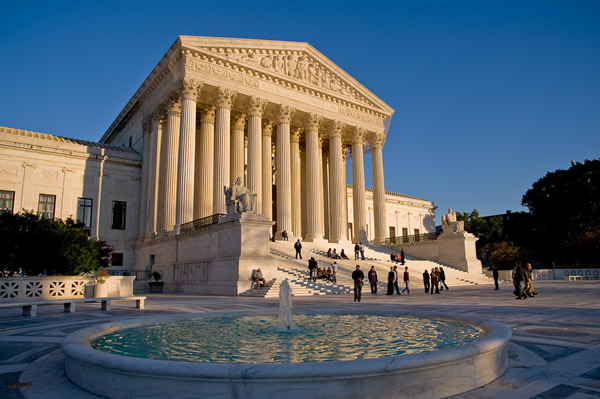The Incoherence of the Normative Case Against Bivens
I’ve already written at some length about the flawed analytical foundations of Justice Kennedy’s opinion for a 4-2 majority in Ziglar v.
Published by The Lawfare Institute
in Cooperation With

I’ve already written at some length about the flawed analytical foundations of Justice Kennedy’s opinion for a 4-2 majority in Ziglar v. Abbasi—Monday’s Supreme Court decision holding that courts could not imply a “Bivens” damages remedy for victims of constitutional violations by federal officers as part of the post-September 11 roundup of immigration detainees in and around New York. In a nutshell, whatever one thinks of the result, the majority opinion rests on a remarkably shoddy understanding of how remedies against federal officers have operated historically, and a patently unconvincing series of analogies to other doctrinal contexts in which courts have, for distinct and distinguishable reasons, increasingly stayed their hand in the absence of affirmative legislative intervention.
But I don’t mean to rehash or otherwise relitigate those arguments here. Instead, I ask a different question: As a normative matter (that is, without regard to historical or doctrinal foundations), is Justice Kennedy’s case against judge-made damages remedies for constitutional violations actually convincing?
As I explain in the post that follows, there are three different defects in his normative case against Bivens: First, it rests on a view of the intrusive effect of Bivens that is not just wholly unsubstantiated but also internally inconsistent as a logical matter. Second, it incorporates into Bivens concerns about undue intrusion that other doctrines already account for in more nuanced, sophisticated ways. Third, and most importantly, it assumes that damages actions represent a greater intrusion into the function of the political branches in general (and in national security cases, specifically) than does prospective relief (like injunctions, habeas, etc). That’s a theory of the separation of powers that, frankly, makes no sense. Certainly one can reasonably be opposed to an aggressive judicial role in national security cases in general, or in cases seeking prospective relief, specifically. But the idea that judicial recognition of an after-the-fact damages suit represents a greater threat to the separation of powers than judicial imposition of an injunction against ongoing national security policies (ranging from the 1973 bombing of Cambodia to military detention at Guantánamo to the travel ban) is, for lack of a better word, nuts.
I. Justice Kennedy’s “Intrusion” Theory
The most important passages of Justice Kennedy’s majority opinion are on pages 10, 12–14, and 17–20 of the slip opinion. In condensed version, Part II of the opinion makes the following claims about the economic and non-economic costs imposed by damages suits:
- “Claims against federal officials often create substantial costs, in the form of defense and indemnification. Congress, then, has a substantial responsibility to determine whether, and the extent to which, monetary and other liabilities should be imposed upon individual officers and employees of the Federal Government.” (p. 10)
- When deciding whether to recognize a judge-made cause of action for a violation of the Constitution, “the inquiry must concentrate on whether the Judiciary is well suited, absent congressional action or instruction, to consider and weigh the costs and benefits of allowing a damages action to proceed.” (p. 12)
- “[T]he decision to recognize a damages remedy requires an assessment of its impact on governmental operations systemwide. Those matters include the burdens on Government employees who are sued personally, as well as the projected costs and consequences to the Government itself when the tort and monetary liability mechanisms of the legal system are used to bring about the proper formulation and implementation of public policies.” (p. 13)
Then, in Part III, Justice Kennedy turns to why these costs are especially pronounced in suits implicating national security policies:
- “[T]he burden and demand of litigation might well prevent [the Abbasi defendants]—or, to be more precise, future officials like them—from devoting the time and effort required for the proper discharge of their duties.” (p. 18)
- “[T]he discovery and litigation process would either border upon or directly implicate the discussion and deliberations that led to the formation of the policy in question. Allowing a damages suit in this context, or in a like context in other circumstances, would require courts to interfere in an intrusive way with sensitive functions of the Executive Branch.” (p. 18)
- “National-security policy is the prerogative of the Congress and President. Judicial inquiry into the national-security realm raises ‘concerns for the separation of powers in trenching on matters committed to the other branches.’ These concerns are even more pronounced when the judicial inquiry comes in the context of a claim seeking money damages rather than a claim seeking injunctive or other equitable relief. The risk of personal damages liability is more likely to cause an official to second-guess difficult but necessary decisions concerning national-security policy.” (p. 19; emphasis added)
- “For these and other reasons, courts have shown deference to what the Executive Branch ‘has determined ... is essential to national security.’ Indeed, ‘courts traditionally have been reluctant to intrude upon the authority of the Executive in military and national security affairs’ unless ‘Congress specifically has provided otherwise.’ Congress has not provided otherwise here.” (p. 19)
- “If Bivens liability were to be imposed, high officers who face personal liability for damages might refrain from taking urgent and lawful action in a time of crisis. And, as already noted, the costs and difficulties of later litigation might intrude upon and interfere with the proper exercise of their office.” (p. 22)
In other words, Justice Kennedy identifies concerns about courts imposing economic and non-economic costs on government officers as the principal separation-of-powers justification for declining to recognize an implied constitutional cause of action for damages, and suggests that those costs are especially pronounced in national security cases (and in contrast to suits for ongoing, prospective relief).
- The Flaws in Justice Kennedy’s “Intrusion” Theory
Justice Kennedy’s discussion of the intrusiveness of judge-made damages remedies both in general and in national security cases, specifically, suffers from at least three independent defects—each of which should be enough to give pause even to those who think he reached the correct result.
First, Justice Kennedy provides no authority to substantiate any of his assertions about the economic and non-economic costs that recognition of Bivens remedies would impose, other than a few stray references to prior Supreme Court decisions (that themselves cited no primary authority). That is to say, he offers no evidence that damages suits actually have the impact he posits. That’s quite likely because they don’t.
For starters, as Justice Kennedy himself concedes on page 10, the federal government generally indemnifies its officers from damages liability for any and all conduct that falls within the scope of their employment. Thus, in point of fact, officers like the Abbasi defendants face no real monetary jeopardy even for actions that are ultimately adjudged to be unconstitutional (which means their conduct is also not protected by qualified immunity, as discussed below). And they also are usually represented by government lawyers and/or by private lawyers who, in most cases, are being paid by the government (or are acting pro bono). The point is not that these suits create no economic costs; far from it. But, contra Justice Kennedy, those costs are invariably borne by the government, not by the officer defendants, a distinction that necessarily undercuts much of Justice Kennedy’s discussion of why those costs are so intrusive.
Second, Justice Kennedy’s concerns about the non-economic costs of such litigation—the impact on officers’ ability to do their jobs because of the burdens of discovery, trial, etc.—are already accounted for elsewhere. The whole purpose of the qualified immunity defense is to protect responsible government officers from these very costs by foreclosing discovery (to say nothing of trial) in any case in which the plaintiff cannot allege facts that, if true, would establish a violation of clearly established law. Thus, although Justice Kennedy worries that “[t]he risk of personal damages liability is more likely to cause an official to second-guess difficult but necessary decisions concerning national-security policy,” that’s the precise justification typically invoked (including by Justice Kennedy himself) to defend the qualified immunity doctrine. To invoke it in this context is to double-count that concern—and to thereby ignore the extent to which those costs are already largely abated by other more carefully calibrated (and case-specific) protections. There’s lots that can—and should—be said about the shortcomings of contemporary qualified immunity doctrine (see, for example, Justice Thomas’s concurring opinion in Abbasi). But Justice Kennedy, as one of its staunchest defenders, seems oblivious to its impact.
Third, the real intrusion Justice Kennedy appears to be worried about—that courts might “interfere in an intrusive way with sensitive functions of the Executive Branch”—is, quite obviously, a much bigger concern in suits for prospective relief (where plaintiffs seek to halt ongoing government action) than in suits for damages years (or, in this case, decades) after the fact. I’ve written about this specific point before, but in short, a court order that the government must (1) halt an ongoing military operation; (2) release an individual in military custody; or (3) stop a new immigration policy that the government has argued is necessary to protect national security should, quite obviously, reflect a far greater intrusion into the “sensitive functions of the Executive Branch” than an after-the-fact damages action. In the former context, there are any number of reasons why courts might not be well-suited to resolve the dispute, foremost among them the difficulty they might have, in the moment, with assessing facts that may only become clear in retrospect. (For example, whether a law enforcement officer faced an imminent threat of harm under Tennessee v. Garner.)
A damages suit raises none of those concerns—especially when accompanied by indemnification and qualified immunity. It imposes costs, to be sure—but those costs seem, to me at least, to pale in comparison to the very real (and real-time) costs that prospective relief imposes (and can impose) on national security policies and policymakers. Of course, some might think that this is therefore a reason to oppose judicial interference across the board in national security cases. Fair enough. My point here is that Justice Kennedy doesn’t. Instead, his opinion is adamant that “[t]hese concerns are even more pronounced when the judicial inquiry comes in the context of a claim seeking money damages rather than a claim seeking injunctive or other equitable relief.”
I’m not sure what more to say about this reasoning than that it boggles the mind. Not only is the degree of the intrusion reflected in a damages suit so obviously lesser than that reflected in a suit for prospective relief, but the suggestion to the contrary implies that Justice Kennedy’s real concern is with the intrusion into not the government’s actions, but those of its officers. That is to say, on Justice Kennedy’s view, the separation of powers, in this context, exists to protect Executive Branch officers from the courts, and not the Executive Branch itself. That view is not only belied by how these cases are actually litigated (and, in the virtually empty set of cases in which plaintiffs prevail, how damages are paid), but it’s a staggeringly wrongheaded assessment—especially in today’s climate—of the role of the courts in our constitutional system.





